Ticks are the most important vectors of disease in domestic and wild animals throughout the world and are second only to mosquitoes as transmitters of human disease. They harbor and transmit various pathogens including protozoa, viruses and bacteria to humans and their companion animals. This guide provides general information about ticks, tick-borne diseases and tick management practices for important biting ticks in Missouri.
Ticks are arthropods that are closely related to mites and spiders. The more than 800 species worldwide are divided into three families, the Ixodidae, Argasidae and Nuttallellidae. The hard ticks (Ixodidae) form the largest family with 14 genera worldwide. They are by far the most commonly encountered ticks feeding on humans or wild and domestic animals. Soft ticks (Argasidae) are less diverse with just four genera worldwide. The family Nuttalliellidae is very rare and consists of only a single African species. North America is home to all four genera of soft ticks and seven genera of hard ticks.
All ticks have a life cycle consisting of an egg, larva, nymph and adult. They eat only blood. All stages and both sexes require a blood meal for proper development. They locate and feed on a wide variety of vertebrate hosts and will normally attack any host they encounter in the environment. Tick-borne diseases result when pathogens acquired from one host infect the tick and are later transmitted to a second host during blood feeding. Management of tick populations is important to minimize the risks of tick-borne disease. Management consists of modifying tick habitats, minimizing host abundance and using personal protective measures such as tick removal, tick repellents and pesticide application when necessary.
Morphology
Tick morphology consists of two primary regions, the mouthparts (capitulum) and the body (idiosoma). The mouthparts on hard ticks protrude in front of the body and are visible from above (Figure 1), but the body of soft ticks extends forward above the mouthparts so they are only visible from beneath (Figure 1). The body of ticks includes the eyes, legs, and respiratory, digestive and reproductive structures.
The mouthparts (capitulum) have three specialized structures called palps, chelicerae and a hypostome that are attached to a base called the basis capituli (Figure 1). These structures function together and allow ticks to penetrate the host skin and extract a blood meal from the tissues below (Figure 1). The palps are leglike structures that do not penetrate host skin but are sensory in function. The chelicerae are cutting organs whose cutting surfaces face outward. They cut by inserting the chelicerae into the skin then pushing them outward from the midline to open a hole that allows the hypostome to be inserted. The hypostome is the attachment organ, and the opening to the digestive tract is found on the tip of the hypostome. Small rows of backward-facing spines (denticles) on the outside of the hypostome help anchor the tick in the host skin tissues. In addition, many ticks secrete “cement” from the salivary glands around the bite site, which functionally glues the mouthparts to the host.
The body (idiosoma) of ticks is typically not hardened to a great extent. In hard ticks, most of the exterior cuticle is soft and has many internal folds that look like grooves on the surface of the body. The uniform, rectangular folds located on the rounded posterior end of hard ticks are called festoons (Figure 1). Unfolding and stretching of the soft cuticle along these grooves allows immature and adult female hard ticks to take enormous blood meals and swell to weigh 50 to 100 times their original weight. Soft ticks show a lot of variation in the structure of their cuticle, including various wrinkles, bumps or nipplelike appendages
Hard ticks possess a single upper plate near the front of the body, which provides protection like a shield (Figure 4). This plate also serves as an attachment point for the many muscles that are associated with the mouthparts. The scutum may show various patches of color, ranging from off-white to gold, green and red. Male and female hard ticks can be distinguished from one another by the size of the scutum. In males, the scutum is large and covers the entire upper surface of the body, whereas in females the scutum is much smaller and covers less than half of the upper body surface, thus allowing the body to greatly expand during engorgement with host blood. Soft ticks rarely possess a scutum, but they have small, smooth, disk-shaped structures that provide sites for internal muscle attachment. These smooth areas are arranged in various patterns. One pair of eyes is normally located near the front corners of the scutum in hard ticks and is found underneath in soft ticks.
The underside of the tick body is where legs and respiratory, digestive and reproductive structures are located. The legs normally have six segments. On the end of each leg is a claw; the tick uses these claws to cling to and move around on the host. The legs have several functions in addition to locomotion. The segment at the base of each leg often has spines that aid in attachment to the host (Figure 1). The segment at the tip of the first pair of legs has a specialized sensory organ called Haller’s organ. This organ is a small capsule that contains heat, moisture and chemical receptors. It functions in a similar way to the antennae of insects. These receptors are very important for tick survival and host location.
On each side of the body, just behind the last pair of legs, is a plate that contains openings to the respiratory system (spiracles). Breathing occurs through these openings and not through the mouthparts. The spiracles are controlled by the tick and can be closed as needed to limit water loss. The anus is located toward the rear of the body and may be bordered by distinctive grooves. The opening of the reproductive system is not next to the anus but is located about halfway up the body between the anus and mouthparts (Figure 1).
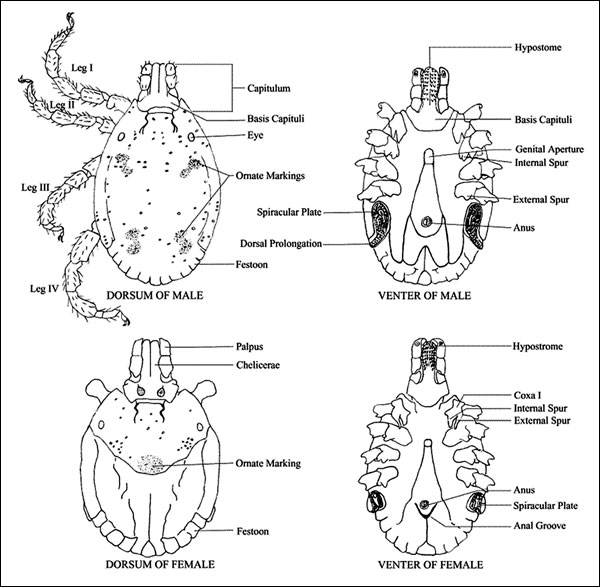
Figure 1
Key physical features of male and female hard ticks on the top (dorsum) and bottom (venter) of their bodies.
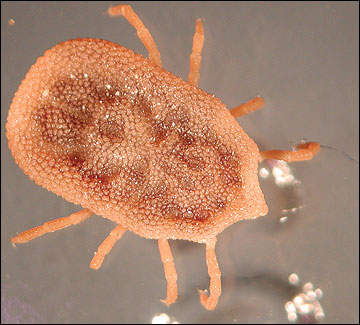 Figure 2
Figure 2
A typical soft tick. Soft ticks have no dorsal shield, are leathery and light-colored, and have small bumps on their bodies.
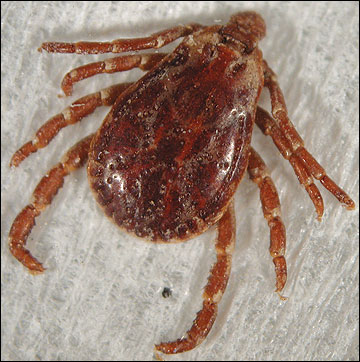 Figure 3
Figure 3
A typical hard tick (male). Hard ticks have a dorsal shield, are hardened and often dark-colored, and have folds on their bodies.
Identification
A brief discussion of tick morphology is a useful introduction to the biology of hard and soft ticks and is also necessary to successfully identify different kinds of ticks using illustrated guides. An illustrated identification key to the genera of hard and soft ticks in North America is shown in Figure 4.
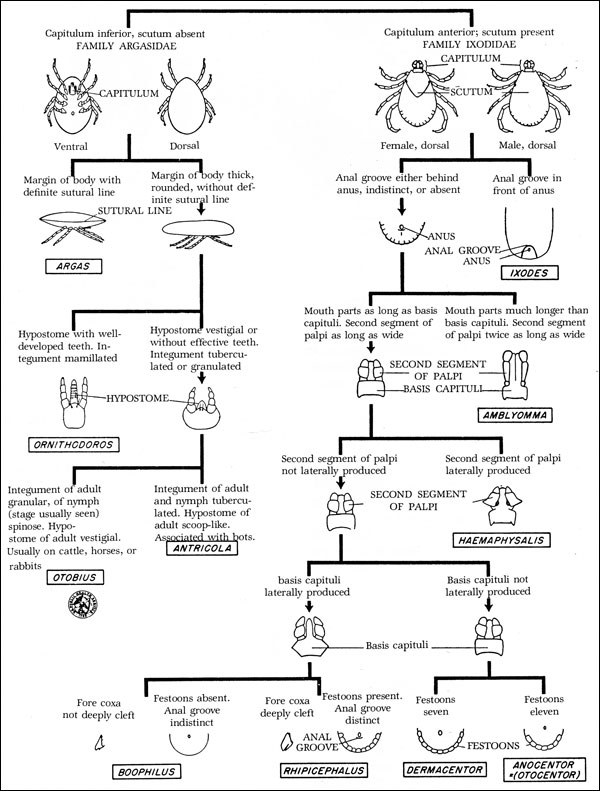
Figure 4
Identification key to the genera of adult ticks in the United States (CDC, Atlanta, GA).
Life cycle
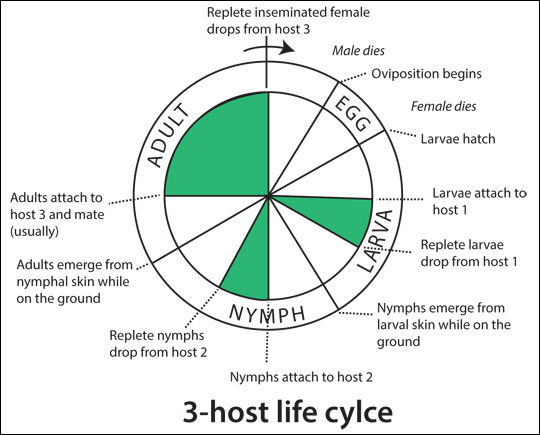
Figure 5
Common life cycle of hard ticks. Most hard ticks are called three-host ticks because they must locate three separate hosts during their life cycle — one for each stage of development. (Note that the on-host periods for each life stage are really very short compared to the total length of the life stage.)
Ticks have a general arachnid development, which includes a six-legged larval stage called a seed tick, followed by an eight-legged nymphal stage, followed by an eight-legged adult stage. Ticks shed their exoskeleton (they molt) between each of these stages. Hard ticks have a single larval and nymphal stage, but soft ticks have more than one larval stage and two or more nymphal stages before becoming adults. The total time for development from egg to adult may take 24 years for hard ticks and 10 years or more for soft ticks. Both sexes of ticks must parasitize and feed on the blood of a vertebrate host in all of their life stages.
Hard ticks all follow a very similar life cycle with little variation (Figure 5). Most are called three-host ticks because they must locate three separate hosts during their life cycle, one during each stage of development. Some hard ticks are called two-host ticks because the larva and nymph feed on the same host and then molt to the adult who finds a new host.
In a three-host tick, the larva must find a host, get on the host, attach to the host, engorge on the host’s blood, drop from the host, and molt to the nymph stage. The nymph must then find another host, get on that host, attach to that host, engorge on that host’s blood, drop from that host, and molt to the adult stage. Finally, the adult must find a third host, get on the host, attach to the host, engorge on the host’s blood, mate on the host, and drop from the host, after which females lay eggs. The three hosts in a tick life cycle may be of the same or different species. Many hard ticks feed on small animals during the larval and nymphal stages and on large animals during the adult stage. This kind of behavior facilitates the movement of pathogens from one host to another.
Soft ticks have life cycles that vary in the number of stages and feeding bouts. They are nest parasites and are likely to feed repeatedly on the same animal or the same family group of animals within the nest. Most soft ticks do not attach to the host or enlarge greatly while feeding. Those that do attach only do so during the larval stage. Nymphs and adults feed quickly on the host while it is in the nest and then return to their resting or hiding place within the nest.
Behavior
Hard ticks spend most of their time on the ground. Larvae hatch from eggs on the ground; larvae and nymphs molt to the next developmental stage on the ground; and adult female ticks are on the ground as they produce and lay eggs. Ticks spend over 95 percent of their lives off their hosts. Most of this time off the host is spent in a state of suspended animation (diapause) both before and just after they molt to the next stage of development. Ticks are able to withstand long periods of starvation while off the host; some studies have shown that unfed ticks can survive more than a year. Interestingly, they may live even longer than some of their hosts. The main stress factor for ticks off the host is water loss from their bodies, which can lead to desiccation.
While on the ground, hard ticks must locate a humid, cool environment to avoid body water loss and desiccation, which would kill them. They typically find a suitable location in the relatively sheltered environment of the layer of soil and leaf litter at the base of the vegetation to enter diapause (Figure 6). In contrast to hard ticks, soft ticks are more specialized for living in dry habitats characteristic of their host’s nesting conditions, and the leathery exoskeleton of soft ticks is more effective for preventing water loss.
The beginning and end of diapause in hard ticks is regulated mostly by soil temperature and hours of daylight. Upon emerging from diapause, hungry ticks climb out of the sheltered soil-litter layer and begin to search for a host using a behavior called questing.
Questing is an ambush strategy in which ticks climb onto vegetation and cling head down to blades of grass or branches of shrubs or trees with their hind legs and hold their forelegs widely out in front of their bodies while waiting for a suitable host to pass by (Figure 7). During this time, they are subject to the warm, dry air currents and begin to lose body water. When body water drops to critical levels, they must stop questing and return to the litter layer where they replenish body water by absorbing water vapor through the exoskeleton.
Questing ticks do not jump, fly or drop from trees onto a host. They climb vegetation to a certain height, based on stage of development, and wait for a passing host to latch onto.
Adults climb higher and therefore are more likely to be found on large hosts, whereas larvae and nymphs, who are more susceptible to desiccation and stay closer to the soil, are more likely to come in contact with smaller hosts. Ticks detect host movement and other cues using Haller’s organ. They use the specialized claws on their front legs to snag onto the body covering (hair, fur, clothing) of passing hosts. In addition to questing, ticks may detect a stationery host using Haller’s organ; studies have shown they may travel up to 32.8 feet to climb onto these hosts. The primary limiting factor to the time spent questing or otherwise searching for hosts is water loss, so air temperature and solar radiation have the greatest influence on tick activity patterns.
Once on the host, ticks instinctively move upward to locate a protected site where they settle down to attach and feed (Figure 8). Ticks begin feeding by cutting a hole in the host skin using the chelicerae. The outer edges of the chelicerae cut the skin, so cutting is done as the chelicerae are pulled apart. The hypostome is inserted into this hole (Figure 9). The salivary glands of hard ticks secrete a cement substance that “glues” the mouthparts in place. If ticks are disturbed during this initial feeding phase, before the cement has locked them in place, they can pull out the hypostome and look for another feeding site. However, after the cement has locked them in place, they cannot detach immediately but rather remain in place until they are dislodged or until they have fully engorged (Figure 10). Inserting the mouthparts normally takes about 15 to 30 minutes but can take up to 1 or 2 hours. Only the slender mouthparts actually penetrate the skin.
All ticks secrete enzymes into the host’s blood to counteract the effects of clotting and maintain blood flow. Hard ticks may feed for three to seven days. Feeding is not continual. Engorgement is slow at first but becomes rapid later, with dramatic increases in size occurring within the last 24 to 48 hours of feeding(Figure 11). Studies have shown that engorged larvae may weigh 7 to 20 times their original weight, nymphs 9 to 80 times their original weight, and adult females 50 to 100 times their original weight. Soft ticks normally feed for less than one hour and do not engorge, so weight gain is not dramatic. The probability of disease transmission increases the longer a tick is attached and feeding.
Adult soft ticks mate while off of the host, but adult hard ticks mate on the host. Males mate with females while the females are feeding on the host. Blood feeding is required by males for their sperm to mature, but they do not engorge as much as females and immature stages do. Males take small quantities of blood as they wait for females to attach nearby where they are able to detect them. When a female is detected, males then detach and mount the engorging female to mate. Female ticks remain receptive following mating, so males normally remain on the engorged female and guard her until she detaches from the host following engorgement. After engorgement and mating, females drop to the ground to lay eggs (Figure 12). After an egg maturation period on the ground of about five to 20 days, the female lays a single large batch of 2,000 to 8,000 eggs, after which she dies.
 Figure 6
Figure 6
Ticks find shelter at the surface of the soil, where the environment is humid and cool, to avoid water loss, which can lead to dehydration and easily kill them. They may also crawl along the ground toward hosts that are resting.
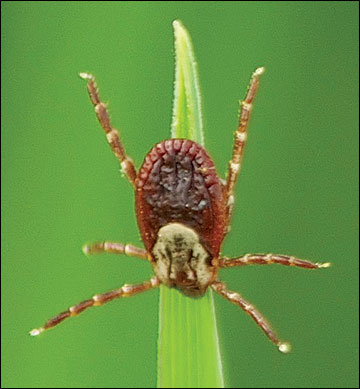 Figure 7
Figure 7
Ticks may use an ambush strategy called questing to find passing hosts. Questing ticks sit on vegetation with their forelegs outstretched waiting for their claws to hook onto a passing host. They do not jump, fly or drop onto the host. Photo by James Gathany, Centers for Disease Control and Prevention.
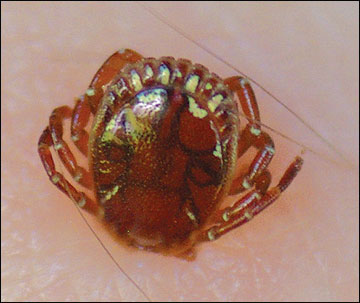 Figure 8
Figure 8
Hard ticks attach to skin of hosts by cutting a hole in the skin with their mouthparts and inserting a barbed feeding tube into the tissues.
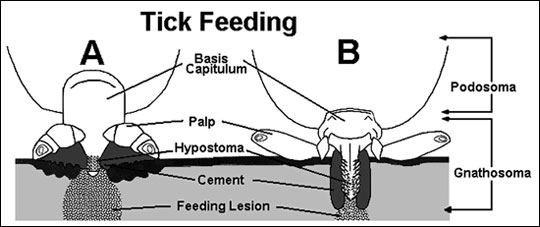
Figure 9
Diagram of tick mouthparts attached to the skin of the host. Some ticks have a short hypostome that does not penetrate deep into the skin; other ticks have a long hypostome. Cement secreted by the hypostome glues the mouthparts into place, either at or under the skin surface.
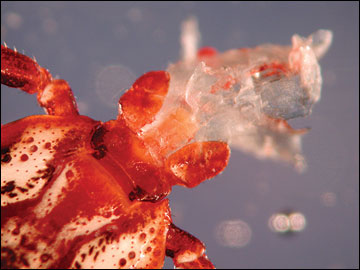 Figure 10
Figure 10
Skin tissues attached to the hypostome of a tick removed from a host. The tissues are attached by cement secreted by the hypostome during feeding.
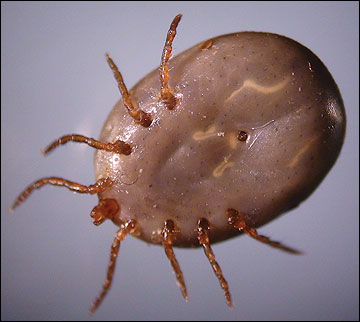 Figure 11
Figure 11
Engorged hard ticks grow significantly in size and weight while feeding on their hosts.
 Figure 12
Figure 12
Female engorged hard ticks lay large batches of 2,000 to 8,000 eggs on the ground after dropping from their hosts. Photo by John Obermeyer, Purdue Extension Entomology.
Distribution and ecology
Ticks are not equally common in all geographic regions. For example, soft ticks are most common in the western and southwestern regions of North America because of their ability to resist desiccation, or drying out. However, hard ticks are generally more common in areas where humidity is relatively high, such as the eastern and southeastern regions of North America. Within these broad geographic regions, the local distribution of favorable microhabitats and suitable hosts predicts where ticks are most abundant in a particular landscape.
Areas in the landscape where humidity is high and hosts are active typically support the highest densities of hard ticks in all stages of development. Some of the most favorable microhabitats occur along the border between a forest and a field. These transition zones, called ecotones, are the transition edges between woodlands and fields or lawns. Ecotones between forests and fields are characterized by a mix of vegetation types, including grasses, shrubs and trees, that grow together to create a “wall” of vegetation. This creates a unique habitat that isn’t found as you move outward toward either the field or the forest.
Ecotones along forest or field edges are important tick habitat for various reasons. Leaf litter that falls from nearby trees onto the ground of an ecotone helps insulate the soil and maintain soil moisture levels. The abundance of vegetation decreases air movement and direct sun, resulting in lower temperature and higher humidity than surrounding areas. It also creates good hiding places for many vertebrate animals that serve as hosts. Small mammals, birds, reptiles and amphibians are all found within ecotones, where the temperature is more moderate and they can hide from predators. All of these factors would seemingly influence the amount of time a tick spends questing, the likelihood of its encountering a host while questing, and its ability to rehydrate its body between questing periods.
Most species of hard ticks are not host specific as larvae, nymphs or adults. They feed on a wide variety of vertebrate hosts, including the majority of mammals, many different birds, lizards, snakes and turtles. They even feed on a few amphibians. Although ticks feed on a wide variety of hosts, one or a few hosts may be very important for a tick population to become abundant. The white-tailed deer (Odocoileus virginianus) is commonly considered to be the most important host for supporting tick populations in Missouri. Large vertebrates like deer are important as hosts for the adult stage of many ticks, and studies have shown that when deer are abundant, ticks are also abundant. Other large vertebrates in Missouri are mostly domestic animals that can be managed in ways to minimize encounters with ticks. No other large vertebrate is as widespread, abundant and available as deer in natural areas across Missouri, and therefore, the adults of many tick species rely on blood meals from this host for reproduction.
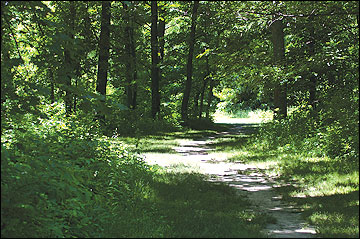 Figure 13
Figure 13
Ticks thrive in ecotones. These transition areas between fields or trails and adjacent forests provide habitat for their hosts and shelter ticks from the sun’s drying effects.
Table 1
Common ticks in Missouri.
| Hard Ticks | Ixodidae | Hosts |
|---|---|---|
| Lone star tick | Amblyomma americanum | Wide range of mammals, birds |
| American dog tick | Dermacentor variabilis | Dogs, opossums, raccoons, foxes,coyotes, squirrels, cattle, sheep, horses, humans |
| Blacklegged tick | Ixodes scapularis | Birds, rodents, lizards |
| Brown dog tick | Rhipicephalus sanguineus | Dogs, other animals occasionally |
| Soft Ticks | Argasidae | Hosts |
| Relapsing fever tick | Ornithodoros turicata | Snakes, birds, rodents, cattle, sheep, horses, pigs, humans |
| Bat tick | Ornithodoros kelleyi | Bats |
Medically important ticks
Although more than 850 species of ticks have been identified worldwide, most of them are not important as disease carriers. This may be related to host preference, geographic distribution or seasonality. The small proportion of tick species that are important in disease transmission have been identified and studied in greater detail. Only a handful of species are commonly associated with human tick bites and disease transmission in Missouri, and most of them are hard ticks. Only one soft tick in Missouri is of medical importance. This section explains the medical importance, identification, distribution and host associations of tick species in Missouri. [Note: Ticks are very small, and therefore are more easily expressed in millimeters (mm) than in inches. One millimeter is less than 4/100 of an inch (1 mm = 0.03937 inch).]
Lone star tick (Amblyomma americanum)
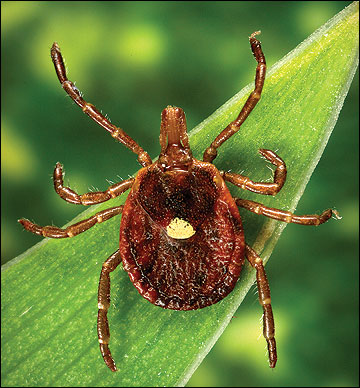 Figure 14
Figure 14
Adult female lone star tick. Photo by James Gathany, Centers for Disease Control and Prevention.
Identification: Hard tick
Adults are about 4 mm long. Females have scutum with distinct white spot. Males have inverted horseshoe markings at the rounded posterior edge of the scutum. Palps are much longer than basis capituli. Palps segment number 2 is at least twice as long as wide. Eyes and festoons are present.
Occurrence and activity
The lone star tick is primarily found in the southeastern and eastern United States. It is abundant throughout the entire state of Missouri. Adults and nymphs are generally active from early spring through midsummer. Larvae are active from late summer through early fall.
Medical importance
The mouthparts on the lone star tick are very large, and their bite may cause locally intense irritation. Massive infestations on animals may result in severe blood loss and debilitation. A toxin introduced during feeding can cause tick paralysis. This tick transmits southern tick-associated rash illness (STARI). It also transmits the pathogens that cause human ehrlichiosis and tularemia. It seems to be a poor vector for Rocky Mountain spotted fever and Lyme disease.
Host associations
Lone star ticks are very aggressive, nonspecific feeders. They feed on a wide range of wild and domestic mammals, groundfeeding birds and humans during all of their life stages. Rodents do not appear to be very important hosts for immature stages. Whitetailed deer are the major host for this tick and an important reservoir for the human ehrlichiosis bacterium. In addition, heavy infestations on deer fawn have been known to result in blindness.
American dog tick (Dermacentor variabilis)
 Figure 15
Figure 15
Adult male American dog tick.
Identification: Hard tick
Adults are about 6.5 mm long. Scutum of both males and females have distinct light coloration patterns. Basis capituli are rectangular. Palps are short, only about as long as basis capituli. Basis capituli and second segment of palps lack lateral projections. Seven festoons present. Anal groove is absent or indistinct.
Occurrence and activity
This tick is widely distributed east of the Rocky Mountains and also occurs in limited areas on the Pacific Coast. It is abundant across the entire state of Missouri. Adults are active from spring through early fall. Nymphs are active from summer through early fall. Larvae are active from early spring through summer. They are most numerous along roadsides, paths and trails in brushy woodlands and meadows with tall grass.
Medical importance
The American dog tick is of the most medically important ticks in the U.S. This is the species most responsible for transmitting Rocky Mountain spotted fever to humans. It also transmits tularemia and causes tick paralysis. One common mode of transmission of Rocky Mountain spotted fever is deticking dogs. Infected tick secretions that get on the hands while deticking may be transmitted through contact with the eyes, mucous membranes or skin cuts or scrapes.
Host associations
Dogs and medium-sized mammals are the preferred hosts, although this tick feeds readily on other common mammals, such as opossums, raccoons, skunks, foxes, coyotes, bobcats, squirrels, cattle, sheep, horses, and humans. Larvae and nymphs feed primarily on small mammals, especially rodents. Adults prefer dogs but also bite humans.
Blacklegged tick (Ixodes scapularis)
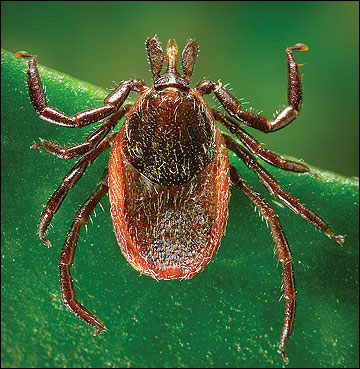 Figure 16
Figure 16
Adult female blacklegged tick. Photo by James Gathany, Centers for Disease Control and Prevention.
Identification: Hard tick
This is a very small tick relative to other species. Adult females are 3 to 4 mm long and adult males 2 to3 mm long. It has an anal groove in front of its anus.
Occurrence and activity
This tick is widely distributed in the northeastern, southeastern and midwestern regions of the United States. In the Southeast, its distribution extends into southern Missouri. It is not common in northern Missouri.
Medical importance
This tick transmits the causative agents of anaplasmosis, Lyme disease and Rocky Mountain spotted fever to humans. Although this tick is abundant throughout its range, the prevalence of Lyme disease is much lower in the southeastern U.S. than in the northeastern U.S.
Host associations
Lizards, birds, rodents and large mammals are hosts. Immature stages feed on lizards, birds and small mammals. Adults prefer deer but will also bite people. The white-footed mouse is the principal reservoir host for Lyme disease pathogens. In the southeastern U.S., the immature ticks feed on lizards instead of rodents and thus are less likely to carry Lyme disease pathogens because lizards have a lower capacity for transmitting the pathogen. This host difference may explain regional differences in the occurrence of Lyme disease despite similar abundance of blacklegged ticks.
Brown dog tick (Rhipicephalus sanguineus)
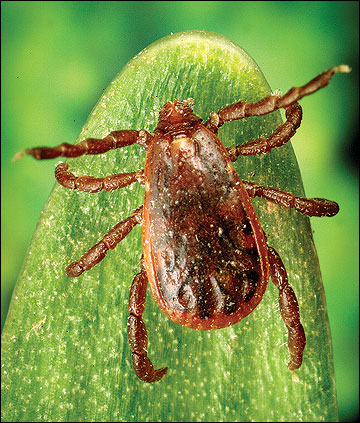 Figure 17
Figure 17
Adult male brown dog tick. Photo by James Gathany, Centers for Disease Control and Prevention.
Identification: Hard tick
Palps are about as long as basis capituli. Basis capituli has lateral projections. Has anal groove behind anus.
Geographic distribution
This tick is one of the most widely distributed of all ticks and is found worldwide. It has been found in all parts of the U.S. but it is most abundant in the southern areas of its distribution. It is also widely distributed in South America, Eurasia, Africa and Australia.
Medical importance
This tick has recently been identified as a vector of Rocky Mountain spotted fever in humans. It is thought to play only a minor role in the transmission of this disease in the U.S., and most humans are infected when removing ticks from their pets. However, it is more likely to cause infections in visitors to Central and South America, where it also reportedly caused a case of tick paralysis in a dog.
Host associations
Dogs are the primary host for the brown dog tick for each of its life stages, and this tick is closely associated with dogs, yards, kennels and veterinary hospitals where dogs are present. Adult ticks feed mainly inside the ears, on the head and neck, and between the toes of dogs. The immature stages feed anywhere on the dog’s body. The immature stages also sometimes attack other animals. This species only occasionally bites humans in the U.S., but some evidence indicates that it is becoming more common on human hosts. In northern areas, this tick is found almost exclusively indoors, where it crawls around baseboards, up walls and into protected cracks and crevices to lay its eggs.
Relapsing fever tick (Ornithodoros turicata)
 Figure 18
Figure 18
Relapsing fever tick.
Identification: Soft tick
This tick has a dark to dirty gray or light black body. Capitulum are not visible from above. Body is covered with short, round bumps and a few nipplelike structures.
Geographic distribution
Relapsing fever ticks are found primarily in the Southwestern regions of the U.S., extending into Texas, Oklahoma, Kansas and possibly Missouri.
Medical importance
This tick transmits the pathogens that cause relapsing fever. Its bite may also produce intense irritation and swelling at the site of the bite.
Host associations
Specimens have been collected from various vertebrate animals including rattlesnakes, turtles, birds, rodents, rabbits, sheep, cattle, horses, pigs and humans.
Bat tick (Ornithodoros kelleyi)
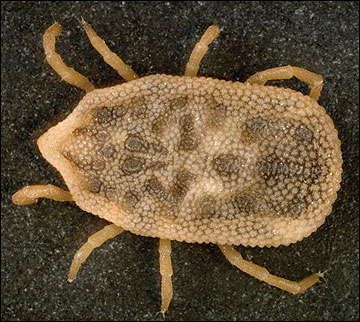 Figure 19
Figure 19
Bat tick. Photo by James Gathany, Centers for Disease Control and Prevention.
Identification: Soft tick
Adults may be up to 10 mm in length. Body is dark to dirty gray or light black and covered with short round bumps. Capitulum is not visible from above.
Geographic distribution
This tick is widespread throughout the U.S.
Medical importance
Most bites go unrecognized and do not cause a reaction in the host. Rickettsia and Borrelia pathogens have been detected in bat ticks, but they have not yet been shown to transmit the pathogens to humans.
Host associations
This species feeds primarily on bats. It has been found on at least five different species of bats and is routinely found in houses and buildings where bats roost. They hide in cracks and crevices in bat roosting areas and feed on the bats as they are resting. This species also feeds on humans. Human feeding typically occurs when the bats have abandoned or are removed from the roost and the ticks become hungry and start to wander in search of something to eat.
Tick-borne diseases
Ticks are suitable hosts to numerous pathogenic organisms. They usually acquire these organisms in the blood meal from their vertebrate hosts who carry the pathogens asymptomatically. When the tick obtains a blood meal from an infected host, the pathogens enter the tick. If the pathogen is able to survive and develop in the tick, it may later be transmitted to humans and cause disease. Tick-borne diseases differ from one another in how they affect human hosts. This section describes each of these diseases and their causative organisms, symptoms, occurrence, transmission and treatment.
Human ehrlichiosis (Ehrlichia chaffeensis and Ehrlichia ewingii)
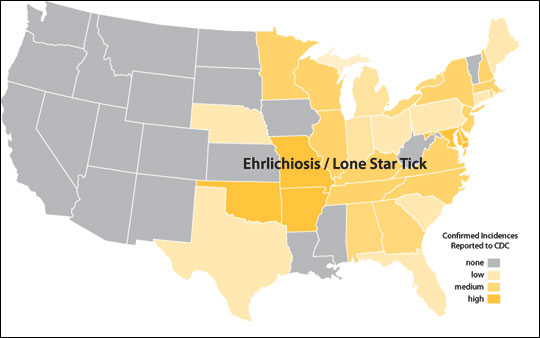
Figure 20
Distribution map of human ehrlichiosis in the eastern United States based on the number of cases per 1 million persons. States with the highest incidence include Missouri and surrounding states. The lowest risks are found in the western United States.
Symptoms
Occurrence: Most cases of ehrlichiosis are reported from the southern, eastern and south-central United States. This corresponds roughly to the geographic distribution of the lone star tick. If you were in an area where ehrilichiosis was common two weeks before becoming ill, tell your doctor.
Transmission
The lone star tick, Amblyomma americanum, is the primary vector of both Ehrlichia chaffeensis and Ehrlichia ewingii in the United States.
Diagnosis and treatment
A diagnosis of ehrlichiosis is based on a combination of symptoms and confirmatory laboratory tests. Ehrlichiosis is treated with a tetracycline antibiotic, usually doxycycline. Although infection has been thought to make a person immune to reinfection, cases of laboratory-confirmed reinfection have been reported.
Rocky Mountain spotted fever (Rickettsia rickettsii)
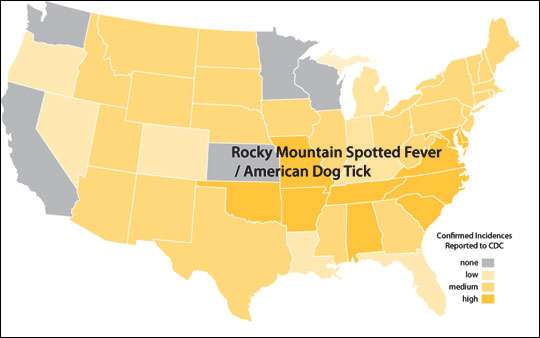
Figure 21
Distribution map of Rocky Mountain spotted fever in the eastern United States based on the number of cases per 1 million persons. States with the highest incidence include Missouri and surrounding states, along with the mid-Atlantic states. The lowest risks are found in the western United States.
Symptoms
This is one of the most severe tick-borne illness in the U.S. and the most common in Missouri. Symptoms include fever, severe headache, abdominal pain, muscle aches, joint pains, nausea, vomiting, diarrhea, and a rash that may cover the entire body. The symptoms typically appear 5 to 10 days following the tick bite. Most cases occur in older individuals. Rocky Mountain spotted fever can be a severe illness, and the majority of patients are hospitalized.
Occurrence
Over half of the cases occur in the south Atlantic region of the U.S. The highest incidence rates have been found in the Carolinas, Oklahoma, and Missouri. Although this disease was first discovered and recognized in the Rocky Mountain area, relatively few cases are reported from that area.
Transmission
The American dog tick, Dermacentor variabilis, is the primary vector in the eastern U.S.
Diagnosis and treatment
Diagnosis is based on a combination of symptoms and confirmatory laboratory tests. The disease is treated with a tetracycline antibiotic, usually doxycycline. Standard duration of treatment is seven to 10 days. Infection with R. rickettsii is thought to provide long-lasting immunity against reinfection.
Southern tick-associated rash illness, STARI (Borrelia lonestari)
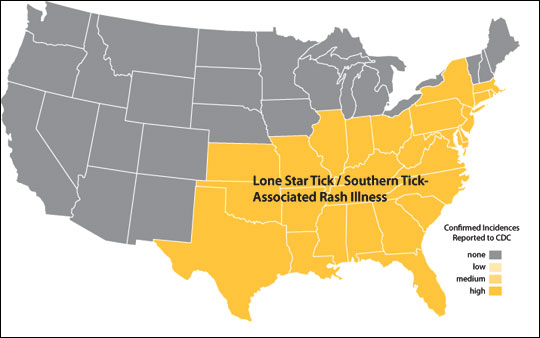
Figure 22
Distribution map of southern tick associated rash illness in the eastern United States.
Symptoms
Symptoms include a bull’s-eye rash that expands to a diameter of 3 inches or more and is often accompanied by fatigue, fever, headache, muscle aches and joint pain. The symptoms usually appear within seven to 10 days of a tick bite. STARI is very similar to Lyme disease but is more common in Missouri. Unlike Lyme disease, STARI has not been linked to any arthritic, neurological or chronic symptoms.
Occurrence
The disease is found from central Texas and Oklahoma eastward across the southern states and along the Atlantic coast as far north as Maine.
Transmission
STARI is specifically associated with bites of the lone star tick, Amblyomma americanum, which is the primary vector in the eastern U.S.
Diagnosis and treatment
An initial diagnosis is based on the patient’s symptoms and history of possible tick exposure. The diagnosis can only be confirmed through laboratory tests. The recommended treatment is a tetracycline antibiotic, typically doxycycline. Antibiotics are usually taken for 10 to 14 days.
Lyme disease (Borrelia burgdorferi)
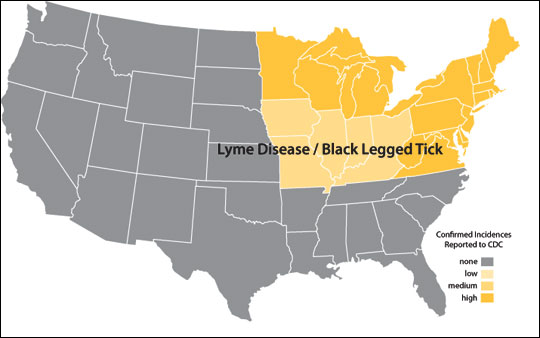
Figure 23
Distribution map of Lyme disease in the eastern United States.
Symptoms
One distinctive symptom is a bull’s-eye rash that gradually expands over a period of several days, reaching up to 12 inches across. It may be warm but is not usually painful. Patients may also experience symptoms of fatigue, chills, fever, headache, muscle and joint aches and swollen lymph nodes. In some cases, patients have only these symptoms and not the bull’s-eye rash. If untreated for several months, over 60 percent of patients begin to have intermittent arthritis, with severe joint pain and swelling. Rates of infection are more common in young children and the elderly.
Occurrence
Lyme disease is most common in the northeastern and upper midwestern regions of the United States.
Transmission
The blacklegged tick, Ixodes scapularis, is the primary vector in the eastern U.S.
Diagnosis and treatment
Laboratory tests can be very helpful but are not generally conducted if the patient has a bull’s-eye rash. However, health care providers should consider other diseases that may cause similar illness, such as STARI. Antibiotics commonly used for oral treatment include doxycycline, amoxicillin or cefuroxime axetil. Patients with certain neurological or cardiac illnesses may require intravenous treatment with drugs such as ceftriaxone or penicillin. Patients treated with antibiotics in the early stages of the infection usually recover quickly and completely. A few patients, particularly those diagnosed with later stages of disease, may have persistent or recurrent symptoms.
Anaplasmosis (Anaplasma phagocytophilum)
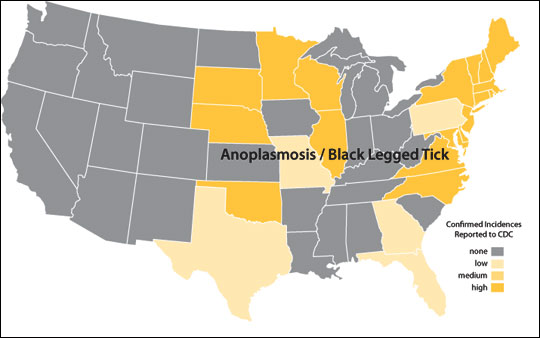
Figure 24
Distribution map of anaplasmosis in the eastern United States.
Symptoms
This disease was previously known as human granulocytic ehrlichiosis (HGE) and later as human granulocytic anaplasmosis (HGA). Symptoms include headaches, fever, chills and muscle aches. Onset generally begins within three weeks (five to 21 days) of a tick bite. The symptoms seem to be most severe in the elderly and immunosuppressed people. Some individuals do not become ill or may experience only very mild symptoms.
Occurrence
About 600 to 800 cases of anaplasmosis are reported to CDC each year. States reporting the highest incidence of anaplasmosis in 2008 were Minnesota, Wisconsin, New York, New Jersey and Connecticut.
Transmission
In the midwestern states, anaplasmosis is transmitted by the blacklegged tick, Ixodes scapularis.
Diagnosis and treatment
Accurate diagnosis of anaplasmosis is often difficult because of the nonspecific nature of the symptoms. An initial diagnosis is based on the patient’s symptoms and a history of possible tick exposure. The diagnosis can only be confirmed through laboratory tests. The recommended treatment of anaplasmosis for children and adults is a tetracycline antibiotic, typically doxycycline. Prescribed antibiotics are usually taken for 10 to 14 days. Infection had been thought to make a person immune to reinfection, but cases of laboratory-confirmed reinfection have been reported.
Tick-borne relapsing fever, TBRF (Borrelia hermsi and other spirochetes)
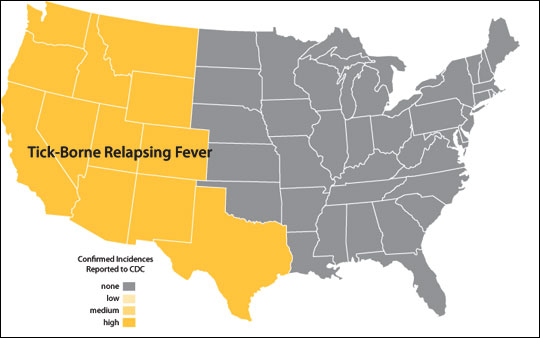
Figure 25
Distribution map of tick-borne relapsing fever in the western United States.
Symptoms
This disease is characterized by recurring episodes of high fever that is often accompanied by headache, muscle and joint pain, chills, sweating and nausea.
Occurrence
TBRF mostly occurs in the western U.S., and travelers to areas where infected ticks occur may return with symptoms. Most infections occur during the summer months.
Transmission
Soft ticks in the genus Ornithodoros transmit relapsing fever. The soft ticks are found in rodent burrows, nests and caves in the western U.S. The ticks live for many years without feeding. Human cases usually occur when people take shelter or stay in cabins infested with infected rodents and these ticks.
Diagnosis and treatment
Relapsing fever has no typical symptoms but rather often has nonspecific symptoms. Initial diagnosis is based on generalized symptoms and a history of possible soft tick exposure, such as sleeping in a cabin. TBRF is treated with one of the following antibiotics: erythromycin, tetracycline, doxycycline or chloramphenicol.
Tularemia (Francisella tularensis)
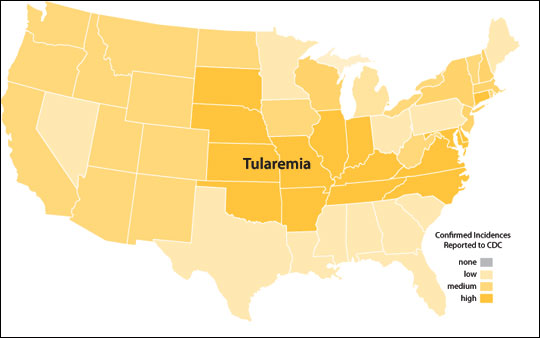
Figure 26
Distribution map of tularemia in the eastern United States.
Symptoms
Fever is the most common symptom of tularemia, and an ulcer usually develops at the site of the bite. Lymph nodes may be swollen. No rash is associated with this infection.
Occurrence
Although tularemia occurs throughout the U.S., most cases are reported from Missouri, Arkansas, and Oklahoma.
Transmission
This bacterium is very infectious, and the tick does not have to be infected to transmit it to another host. It can simply be transmitted on contaminated mouthparts of any tick that has fed on an infected host. The disease may also be contracted by handling infected dead animals, being bitten by an infected animal, drinking contaminated water, or having contact with contaminated materials. The most commonly infected animals are rabbits, voles, mice and squirrels. Pneumonic, or lung-related, cases of tularemia resulting from running over an infected rabbit with a lawnmower have also been reported. Tularemia is so infectious that it has been listed as a potential bioterrorism agent.
Diagnosis and treatment
Diagnosis is usually confirmed in a laboratory using an antibody test. Tularemia is usually treated with one of the following antibiotics: ciprofloxacin, streptomycin or gentamicin. Tetracycline or chloramphenicol are less effective, and tularemia relapses are more common when they are used.
Individual personal protection (IPP)
Individual personal protection (IPP) is absolutely necessary to defend against tick-borne diseases. Reductions in tick populations through host and habitat management alone may not significantly reduce tick-borne disease incidence unless combined with individual personal protection practices. Personal protection measures are necessary because just one undetected bite from a single infected tick can cause a tick-borne disease. So even if host and habitat management were to eliminate all but one of the ticks in an area, you are still at risk of getting a tick-borne disease if that one tick is infected and bites you. Proper IPP occurs in one of three ways: tick bite prevention, prompt and proper tick removal, and postbite monitoring and treatment when necessary.
Note
The University of Missouri intends no endorsement of products named or pictured herein nor criticism of similar products that are not mentioned.
Tick bite prevention
Ticks do not jump, fly or drop from trees. They sit on grass, leaf litter or other areas low to the ground where they have easy access to soil moisture, which they need to keep their bodies from drying out. Most ticks are therefore picked up on the lower legs then crawl upward on the body seeking access to skin where they can settle and feed. This behavior is especially true of larvae (seed ticks) and nymphs since adults may occasionally be found in shrubs a few feet above the ground.
The first step in defending against tick bites and tick-borne diseases is to wear clothing that prevents ticks from getting on your skin and biting. Wearing light-colored clothing with the shirt tucked into long pants, and long pants that are tucked into the top of socks helps keep ticks on the outside of clothing away from the skin and makes them more visible so they can be removed quickly. Taping the bottom of pant legs closed can also keep ticks from getting to skin. Because larval and nymphal ticks may be small enough to penetrate openings in socks that have a coarse weave, using a tick repellent on socks is advisable.
Spray-on repellents significantly increase the level of protection against tick bites. DEET is the most effective, broad-spectrum repellent ever discovered for use against arthropods. It is effective against not only ticks but also chiggers, fleas, mosquitoes and biting flies. The U.S. Environmental Protection Agency (EPA) has concluded that the normal use of DEET does not present a health concern to the general public when used according to the directions on the label. DEET has been used by many millions of Americans since 1957, and the incidence of adverse reactions is low. The few allergic or toxic reactions that have been reported involved the use of high concentrations, over-application or ingestion, which are all contrary to label directions.
DEET is available in concentrations ranging from 5 percent to 100 percent. Products that can be applied to skin or clothing are available in the form of aerosols, pumps, sticks, lotions, creams or towelettes. The duration of protection varies according to the concentration. Higher concentrations of DEET provide longer protection, but the relationship is not proportional, so doubling the concentration does not double the length of protection. Spray formulations of DEET are effective for longer periods when applied to clothing. When applying on skin, oily or creamy DEET formulations may provide longer protection than aerosol sprays. One study found that a DEET concentration of 24 percent provided about five hours of protection against mosquitoes. Normally, protection is shorter for ticks than mosquitoes. For the blacklegged tick, a 30 to 40 percent concentration was shown to be effective for four hours. Lower concentrations of around 10 percent were shown to provide about two hours of protection against mosquitoes and would probably provide less for ticks.
Products containing a variety of other ingredients are sometimes used as repellents. Some of these products are botanicals that contain oil of citronella, soybean, eucalyptus, peppermint, lemongrass, geranium or cedar. Nonbotanical repellents include IR3535 (ethyl butylacetylaminopropionate) and Skin So Soft bath oil. These products provide protection for a much shorter time than DEET (some for as little as 10 minutes), and most don’t even claim to protect against ticks. One study found that IR3535 repelled blacklegged tick nymphs for 34 hours. Most plant oils have not demonstrated reasonable protection, or aren’t even labeled, against ticks.
Permethrin is a spray-on insecticide that is applied to clothing or other fabrics and provides long-term protection. Technically it is not a repellent because it kills ticks that come into contact with treated fabric rather than repelling them. Because of the killing action, it provides a high level of protection against ticks and mosquitoes. Permethrin is not readily absorbed through the skin, and is easily metabolized and excreted from the body, so it is relatively nontoxic to humans. Permethrin products are available as aerosol sprays or pumps and are often sold at stores that sell camping, fishing or hunting supplies.
Permethrin can cause an adverse skin reaction when applied directly to the skin, so products containing this ingredient should not be applied to clothing while it is being worn. Treated clothing must be allowed to dry completely (24 hours) before it comes into contact with skin. Once the product has dried, protection against ticks usually lasts for several weeks and persists through multiple launderings. Most labels recommend that clothing not be treated more than once every two weeks and that treated clothing be laundered at least once between treatments.
Medical and safety information about repellent ingredients can be obtained from the National Pesticide Information Center:
- Online npic.orst.edu
- Email npic@ace.orst.edu
- Phone 800-858-7378
 Figure 27
Figure 27
When going into tick-infested areas, tuck pant legs into socks or tape them closed to keep ticks from getting onto skin. Photo by Pete Teel, TAMU.edu.
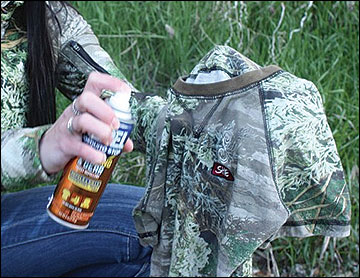 Figure 28
Figure 28
Spray-on tick repellents are effective in keeping ticks off clothing and skin.
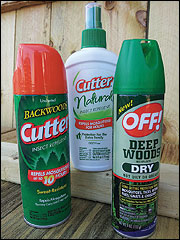 Figure 29
Figure 29
Various tick repellents are available for purchase over-the-counter. Be sure to read the label carefully to avoid unnecessary risk of exposure.
Tick checks
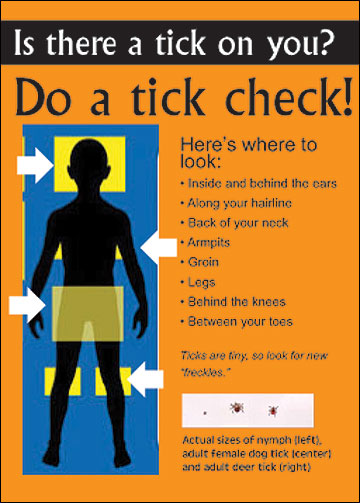 Figure 30
Figure 30
To prevent possible infection with a tick-borne illness, check for ticks within 24 hours of being in areas of tick activity.
Checking your body and promptly removing ticks after being in areas of suspected tick activity is the best way to prevent infection with a tick-borne disease. Transmission of many diseases normally takes up to 24 hours of attachment and feeding, so prompt inspection of the body and removal of attached ticks greatly reduces the chances of infection. Do not wait to feel a tick biting before you perform a tick check. Tick bites are usually painless. If you wait to feel a bite before checking for ticks, your risk of infection is considerably higher.
Immediately after being in an infested area, carefully inspect your entire body for ticks, as follows:
- In a private place with a mirror, remove all your clothing.
- Starting with the lower body, where most ticks are normally found, check the ankles, legs and backs of knees.
- Check at the base of leg hair to find even the smallest stages that may be attached to the skin.
- Check the thighs, groin, pubic area and buttocks. Use a handheld mirror to see the backs of the thighs, under the buttocks and around the genitals. Use your fingers to carefully check crevices and areas where ticks may be attached beneath pubic hair.
- Continue up the body, checking around the waist and chest.
- Use the mirror to check your back.
- Thoroughly check armpits and the base of armpit hair because ticks prefer warm areas of the body.
- Finally, check around the neck, ears and hairline. Using a handheld mirror and your fingers, very carefully check in the hair, especially areas within a few inches of the hairline.
Wash and dry all clothing that was removed. Some species of ticks can survive washing in hot water, but all ticks die within one hour in a hot dryer.
Tick removal
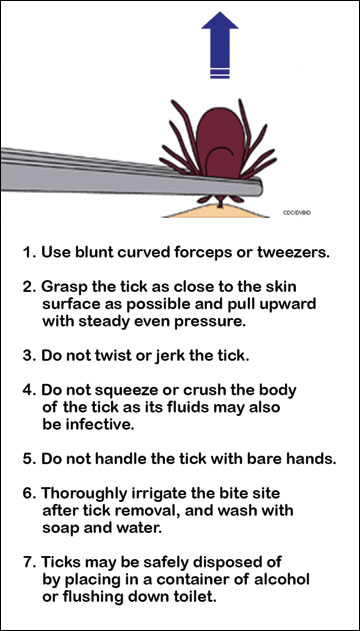 Figure 31
Figure 31
Tips for successful tick removal. Figure by CDC.
The goal of tick removal is to extract the tick from the skin with the body and mouthparts intact. Adult ticks are typically more difficult to remove than nymphs or larvae because their mouthparts are longer. If the mouthparts break off and are left in the skin during removal, the chance of disease is not increased, but the wound will take longer to heal.
To remove a tick properly, use tweezers or forceps with a small tip. Reach under its body and grasp the tick right next to the skin at the point where it is attached. Pull straight upward firmly and steadily — do not jerk — to stretch the skin. Let the elasticity of the skin pull the skin away from the embedded mouthparts. This method should remove the tick with the mouthparts still intact. Avoid grabbing the tick’s body with the forceps as you will be more likely to break the body off and leave the mouthparts embedded in the skin. Commercial tick-removal tools vary widely in their effectiveness at removing the entire tick and mouthparts intact. Using petroleum jelly to suffocate a tick does not work. Once a tick has started feeding, applying chemicals or a hot match to it will not make it back out of the skin. Many ticks secrete a cement substance that anchors their mouthparts into the skin and prevents them from being able to extract their mouthparts until they are fully fed, or engorged.
Self-monitoring and medical treatment
After removing a tick, treat the area with alcohol, disinfectant or topical antibiotics to reduce the risk of secondary infection. Save the tick in a small plastic vial (for up to two weeks) in case there is a need to examine it later. Record the date of removal and the location on your body from which the tick was removed. Finally, watch for signs and symptoms of a tick-borne disease. General symptoms include headache, fever, muscle pain, joint pain, nausea, vomiting and diarrhea. Disease-specific symptoms are described in the Tick-borne diseases section.
A localized bite reaction may develop quickly around the area of the bite. These localized reactions typically disappear within 24 to 48 hours. If the mouthparts were not removed with the tick, they can cause an irritation much like a splinter does, where the body attempts to reject the foreign object. A small hardened spot called a granuloma can persist for weeks as the body breaks down the mouthparts. This granuloma is not in itself a reason to see the doctor, but a doctor should be notified if there is evidence of a secondary bacterial infection in the area of the bite. Evidence of secondary bacterial infection includes localized redness, swelling, heat and pain. Localized pain is one of the most common symptoms of secondary bacterial infection.
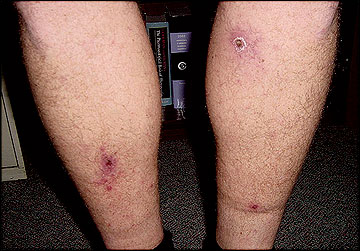 Figure 32
Figure 32
Localized bite reactions may include redness and swelling from infection or a small hardened spot called a granuloma. Photo by CDC.
Follow-up
If you develop a rash or fever within several weeks of removing a tick, see your doctor. Be sure to tell the doctor about your recent tick bite, including when it occurred and where you most likely acquired the tick.
In most cases, if you have symptoms of a tick-borne disease and have noted the date of tick removal and brought the tick specimen with you, a doctor will start antibiotic treatments. Antibiotics are very effective at combating tick-borne illnesses. If antibiotics are administered when the symptoms first appear, the symptoms disappear and long-term or chronic effects are rare. However, if you do not see a doctor and do not take antibiotics, the symptoms will eventually pass, but you are at risk of experiencing of long-term effects such as chronic headaches, fever, muscle or joint pain, nausea or diarrhea. These chronic symptoms do not respond to treatment.
Preventive antibiotic treatments have generally not been recommended in the U.S. because they are not necessary in most tick bite cases. Preventive treatments are not recommended for three reasons. First, the risk of infection from a single tick bite appears to be very low. Second, the risk of adverse reaction by individual patients to antibiotics, although low, may not be worth taking unnecessarily. Third, medical personnel often misidentify specimens as ticks and might therefore administer the preventive treatment unnecessarily.
Integrated Pest Management (IPM) of tick populations
Integrated pest management (IPM) is an approach to pest management that involves using several methods to reduce a pest population to an acceptable size. IPM uses a blend of physical, biological, cultural and chemical strategies to reduce pest populations. IPM may not always eliminate the entire pest population, but it can provide ecological and economic benefits that outweigh the costs related to complete pest population elimination. The ultimate goal of tick IPM is to reduce the number of human cases of tick-borne disease by reducing the risk of encountering infected ticks in the environment. Tick IPM generally combines cultural strategies to reduce tick habitat and host abundance with chemical strategies that use pesticide applications to directly reduce tick numbers.
Reducing tick habitat
The number of ticks, or tick abundance, in an area relates to the presence of landscape features that provide good habitat for ticks and their animal hosts. Landscape features that could lead to more ticks include canopy vegetation that provides shading, groundcover vegetation that maintains surface humidity, and wooded or brushy areas that provide homes for hosts. Wooded areas, lawn perimeters, groundcover plantings, leaf litter, and walls or piles of stone and wood are landscape features normally associated with tick activity. These features are often associated with ecotones, which are the unmaintained transitional edges between woodlands and fields or lawns.
Properly managed landscapes minimize the amount of habitat available for tick populations. In general, fewer ticks are found in well-maintained lawns and gardens. Removal of overgrown vegetation results in higher temperatures, lower relative humidity and reduced soil moisture, the combination of which leads to more tick deaths. When temperatures are increased, humidity levels lowered and wildlife activity discouraged in the yard and garden, these areas become less hospitable to ticks.
Maintenance practices that reduce tick populations around the home and yard include pruning trees, mowing and trimming grass, removing leaf litter, cutting weeds along fences and walls, and trimming low branches on shrubbery to allow air circulation under shrubs. These practices are especially important in areas that are adjacent to woodlands or stonewalls and where heavy groundcover and ornamental shrubs are located near lawns; in these situations, even well-maintained lawns may have many ticks.
The following list provides basic recommendations for tick habitat management around the lawn and garden:
- Open as much of the lawn as possible to sunlight exposure. Bright, sunny, mowed grassy areas are less likely to have ticks. This practice also reduces tick and small mammal habitat and hiding space. If open lawn spaces are not desired, at least open the lawn and garden areas where most human activity occurs.
- Remove the piles of dead leaves, or leaf litter packs, that accumulate around the edges of yards and gardens. Leaf litter and other plant debris can be raked or blown out from under shrubs and bushes and then composted or bagged and removed from the area. Leaves should not just be moved to other areas of the landscape.
- Clean up vegetation around and seal cracks in stone walls in the yard. Eliminate stone and wood piles.
- Isolate tick habitats or tick hot spots along the edges of your yard and garden using 3-foot-wide mulch or gravel barriers. Mulches that are used to suppress weeds and retain soil moisture for plants can also help reduce tick movement and abundance. Use high-quality materials that do not degrade quickly for optimal effect.
- Consider using shrubbery and plantings that have low water requirements and do not attract deer. Frequent watering of shrubbery provides a good moisture source for ticks. Butterfly gardens, formal herb gardens and wildflower gardens are less dependent on watering and are not as attractive to deer.
- Hardscape yard areas where most human activity occurs. Hardscaping includes brick, paving, decking, gravel, container plantings or concrete. Patios, play areas, eating areas, pool decks or paths made of these materials help minimize human exposure to ticks.
- Controlled burning of tall grassy fields, woodlots and similar areas to modify habitat is a management practice long used by farmers, ranchers and foresters. Controlled burning has been shown to reduce tick numbers temporarily in some studies.
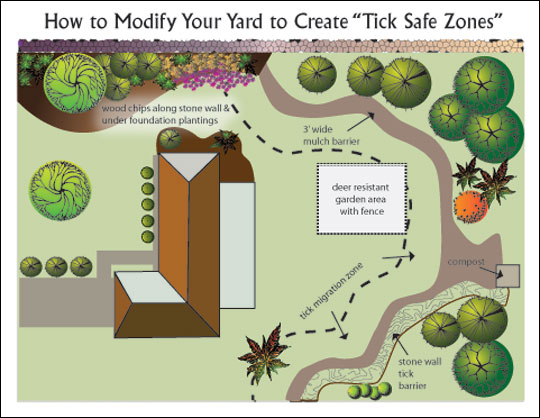
Figure 33
Landscapes around the home can be modified to create zones of decreased tick activity by mowing, burning, mulching, and planting shrubs and other plants that minimize activity by animal hosts.
Managing host abundance
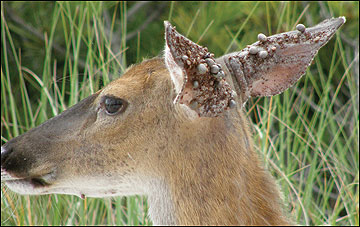 Figure 34
Figure 34
Deer can harbor hundreds of engorged ticks behind their ears; the ticks drop off in areas where the deer pass through or rest.
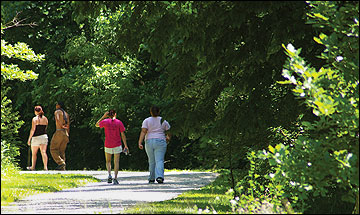 Figure 35
Figure 35
Human-made landscapes offer great places for deer to hide. Many states report that deer populations are rapidly increasing in urban areas.
Wildlife requires adequate food and shelter to survive and reproduce, so the primary goal of tick host management is to minimize essential resources for wildlife in areas where humans spend most of their time outdoors. Residential landscapes can be attractive to a variety of wildlife, of which several species may be tick hosts.
The combination of host species in an area is called the “host pool.” Each species in the host pool contributes to the number of infected ticks in the area. Several mammals, birds and reptiles are potential hosts on which ticks feed and grow. When these potential hosts are present in large enough numbers, tick activity can increase. Deer and rodents, in particular, are hosts that can infect ticks, so tick numbers and disease transmission will be higher in landscapes that favor them.
White-tailed deer
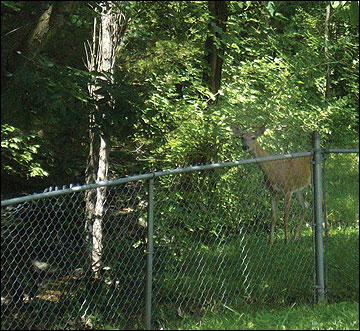 Figure 36
Figure 36
Deer thrive in areas of bush honeysuckle, and ticks are more abundant where this plant is found.
The key wildlife host that influences tick abundance in Missouri is white-tailed deer (Odocoilius virginianus). The abundance and distribution of many tick species has been shown to be directly related to the size of deer populations. When deer populations increase, tick populations increase; and when deer populations decrease, tick populations decrease. According to estimates, over 90 percent of all ticks feed on deer during their adult stage, so in areas where deer are numerous, adult ticks are likely to find a blood meal and reproduce. So, areas with large deer populations can be expected to also have large tick populations and, therefore, a greater potential for tick-borne disease transmission.
Deer activity also influences where ticks are found in a landscape. Deer transport ticks during their daily activities. When the ticks have finished feeding, or are engorged, they drop from the deer along trails where the deer walk or in brushy areas where they feed and sleep. Engorged female ticks that have dropped then produce thousands of eggs that hatch into hungry immature ticks. These new ticks seek nearby small animals to feed on. These thousands of young ticks also may either produce new tick populations in previously tick-free areas or reinforce existing tick populations.
A mixture of light-fragmented woodland and woodland edges with clearings, shrubs, grasses and a lack of predators is the ideal environment for deer and is also characteristic of human-made landscapes. Deer thrive in human suburban environments. Many states estimate that their deer populations were in the hundreds to a few thousand in the late 1800s or early 1900s but now number in the hundreds of thousands or millions. Various recommendations have been developed to curb continued deer population growth, especially in urban and suburban areas.
Deer population control requires consistent effort and, often, a combination of methods. Deer have a high reproduction rate, and given the right conditions, herds can potentially double in size in a single year. Deer population control programs, therefore, begin with an initial phase to reduce the herd and require long-term herd maintenance to keep the population low.
Fencing
Fences can control deer access to certain defined areas of a landscape, including gardens and small to moderate-sized yards. Many types of fences are available. Selection depends on the characteristics of the landscape and the amount of deer pressure that is expected. Fences commonly used to exclude deer include wood privacy, wire mesh, chain link and electric. Fence height is not as important as many people think it is. Although deer can jump an 8-foot-tall fence from a standing position, they rarely do so and are more likely to try to push under the fence. Before installing a fence, check local restrictions on the type and height of fencing that is allowed in a community or neighborhood.
Deer-resistant landscape plantings
Deer are “browsing” animals, which means they eat a variety of plants. The use of plants that are not preferred by deer has been suggested as a way to discourage browsing in yards and gardens and to make areas around the home less attractive to deer. Because no landscape plant is entirely browse-resistant to deer under all circumstances, this method is unlikely to completely eliminate deer activity in all areas of a yard. However, if your yard seems less delicious than other nearby areas of the landscape, deer will spend less time there. Homeowners disagree about the relative value of native and nonnative landscape plantings, but deer-resistant varieties of both native and nonnative plants are available.
Deer repellents
Deer repellents are usually bad-tasting or -smelling chemicals that are applied to vegetation or other landscape features to discourage deer activity in an area. Repellents only make that area relatively less hospitable than nearby areas, and their performance varies depending on the product, rain patterns, frequency of application and availability of nearby areas suitable to deer. When applied correctly, some repellents can effectively discourage deer activity in areas with small numbers of deer.
Deer hunting
Hunting has a direct and certain impact on deer population size. Some communities have explored the use of regulated hunting or controlled hunts to reduce deer abundance. This management option can be effective, but some residents may object. When a lethal deer management program is implemented in urban or suburban areas, several issues may need to be considered, including hunting restrictions, real or perceived safety or liability concerns, conflicting attitudes about wildlife management, property ownership issues and hunter access.
Small mammals and rodents
 Figure 37
Figure 37
A wide variety of small animals, including rabbits, serve as hosts for ticks and pathogens. Photo by CDC.
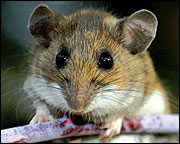 Figure 38
Figure 38
The white-footed mouse is an important host for various tick-borne pathogens. Photo by CDC.
A wide variety of small mammals can serve as hosts for ticks and the pathogens they transmit. These potential hosts include mice, squirrels, rabbits, shrews, voles, raccoons, opossums, skunks and groundhogs. The importance of each of the different small mammals in the dynamics of tick-borne diseases depends on the abundance of each type of host, the number of ticks that use each type of host, and the ability of each host to infect ticks with a particular pathogen. Certain host species are more abundant, more likely to infect ticks, or may predominate in certain years and locations depending on local environmental conditions.
White-footed mice (Peromyscus leucopus) are important hosts for the pathogens that cause ehrlichiosis, Lyme disease and babesiosis. They are capable of carrying one, two or all three pathogens at the same time. This species has been shown to infect more ticks with Lyme disease than other common small mammal host. One study demonstrated that it would take 12 chipmunks or 221 voles to infect as many ticks with the Lyme disease pathogen as a single white-footed mouse can. In contrast, tree squirrels were shown to infect very few ticks with Lyme disease and may be important only for maintaining tick populations rather than for disease transmission, thus decreasing the number of infected immature ticks in an area. Most of the information available on the role of small mammals in spreading tick-borne diseases concerns Lyme disease transmission; little information is available about which small mammals are the most involved in the transmission of ehrlichiosis, Rocky Mountain spotted fever, babesiosis and other tick-borne diseases.
White-footed mice are very territorial and have home ranges of up to 1/2 acre. Mouse densities are normally around 110 mice per acre and may go unnoticed. The mice are nocturnal and nest in woodland and brushy areas, taking advantage of stone walls and piles, tree cavities, abandoned squirrel or bird nests, stumps and logs. In winter, they readily enter buildings and will nest inside. During the winter and inside buildings, the mice don’t harbor ticks. They are omnivores — feeding on acorns, seeds, fruits, insects, snails, young plants and carrion.
Reducing the abundance of small mammals, especially mice, near homes is very important for controlling ticks. Techniques for reducing mouse habitat includes mowing, trimming and removing tall or dense vegetation and ground cover plantings that provide cover. Removing shaded stone and wood piles or fences also eliminates excellent habitat for mice and other small mammals. If keeping a stone fence or hedge is desirable, check and seal all cracks and crevices regularly with folded hardware cloth (1/4-inch wire mesh) to keep mice from getting inside. Folded wire mesh should also be used to keep mice out of buildings. Encouraging mouse predators like snakes, hawks, owls, weasels and foxes to live nearby can also decrease the number of mice in an area.
The following techniques are recommended for managing small mammal populations in an area:
- Keep potential mouse nesting sites such as stone and wood fences or piles free of brush, high grass, weeds and leaf litter.
- Move stacked firewood away from the home.
- Using caulking and wire mesh, seal all cracks and crevices in old garden sheds or outbuildings to keep mice out.
- Seal or rework cracks and crevices in stone walls or foundations around the home.
- Seal openings under and around old sheds and foundations. Use cement slab foundations wherever possible.
- If garden sheds are slightly elevated off the ground on cement blocks, discourage burrowing of skunks, raccoons and groundhogs with a barrier of wire mesh buried in the ground to a depth of at least 2 feet.
Birds
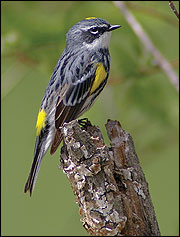 Figure 39
Figure 39
Birds may serve as hosts to immature ticks, but not to adult ticks.
Many birds serve as hosts to immature ticks; in one study, 26 percent of captured birds were infested. However, adult ticks do not feed on birds. The contribution of birds in general to the number of infected immature ticks in a typical area is unknown. For example, the American robin, grackle, common yellowthroat, Carolina wren and house wren can all infect ticks with the Lyme disease pathogen, whereas the wood thrush and gray catbird do not. How these or other bird species influence the number of immature ticks infected with ehrlichiosis, Rocky Mountain spotted fever or babesiosis is also unknown. A recent study suggested that most birds probably contribute few infected ticks to an area and may instead dilute the number of infected ticks by reducing the number that feed on important pathogen-transmitting hosts like mice.
Bird feeders in landscaped areas like mowed lawns do not appear to increase the number of ticks in an area. However, higher tick abundance has been observed where bird feeders were installed along the edge of the lawn in ecotones or wooded areas with suitable habitat for rodent activity or tick survival. Many berry plants are important food for fall migrating birds, but the impact that the presence of fruit-bearing shrubs or trees used by birds as food has on tick abundance is unknown.
Fruit-bearing shrubs that are good for birds and also deer-resistant include bayberry, Virginia creeper, viburnum and highbush blueberry. Fruit-bearing shrubs that are good for birds but also subject to deer browsing are cedars, certain holly cultivars and winterberry.
Managing tick abundance — pesticide use and safety
A pesticide used for ticks is technically called an acaricide. Acaricides are the most effective way to reduce tick populations in small areas, especially when used along with habitat-and host-management strategies. Acaricides can be used to treat areas up to 10 acres, but spraying larger areas becomes more complicated and may create environmentally sensitive situations. However, when used in smaller areas, acaricides provide consistent control, are relatively inexpensive, and are easy to apply.
Limit acaricides applications to tick habitats or “hot spots.” Spraying of mowed open fields and lawns is usually unnecessary. Ecotones are usually the best tick habitat, so treat areas where lawn or fields meet wooded areas. Spray several yards into the edge of bordering woodlands because these are areas of high tick abundance. Spray around stone and wood walls or piles, ornamental plantings and groundcover vegetation in areas that are frequently used by people, such as play areas, gardens, walkways and storage sheds. Do not spray herb and vegetable gardens whose contents will be used for human consumption. Also avoid spraying butterfly gardens or flowering plants visited by bees to minimize pesticide effects on these insects.
A small amount of acaricide applied to tick hot spots at the right time of year can have a big effect on the tick population. Two applications are normally required annually, one in late spring or early summer and another in fall, to have the biggest impact on immature stages of a tick population. The effectiveness of these applications depends partly on tick activity, so applications should not be made in cold weather when ticks are inactive as this will minimize the effects of the acaracide. In addition, tick activity varies with the time of day, so applications should be made at a time of day when ticks are most active.
Choosing an acaricide
Several acaricides are registered with the U.S. Environmental Protection Agency for chemical management of ticks. Some are classified as restricted-use pesticides because they are available only for licensed pesticide applicators, but many products are general-use pesticides, which can be purchased over the counter and used by anyone.
All acaricides are evaluated before registration for several factors:
- Effectiveness
- Toxicity
- Environmental impact
- Formulation type
- Application method
Acaricides differ in their effectiveness on ticks and toxicity to humans, wildlife, aquatic organisms and nonpest insects. The following list provides some general recommendations for choosing acaricides for tick control:
- Both liquid and granular formulations have been shown to be effective, but better control is usually achieved using liquids. Use enough liquid with sufficient pressure to get thorough coverage and penetration of vegetation and leaf litter. A small hand-pumped sprayer is usually not adequate. Consider using some type of garden hose sprayer to achieve sufficient volume and pressure needed for thorough coverage.
- Granular formulations may not be labeled for wooded areas and may only be spread on lawns where acaricides applications for ticks are not usually needed. Check the label carefully.
- Synthetic pyrethroids are the most commonly used acaricide ingredients found in general-use pesticides labeled for ticks. They are derivatives of natural pyrethrum that are chemically modified to increase stability and toxicity. Synthetic pyrethroids are effective at killing ticks at lower concentrations (645 times less) than compounds previously used for tick management. They are available either as concentrates or ready-to-use products. Their names typically end in the suffix -thrin, and several active ingredients are available (Table 2) as concentrates or ready-to-use products.
- Natural pyrethrin with a synergist called PBO (piperonyl butoxide) applied with insecticidal soap or diatomaceous earth was shown in one study to have some effect on ticks.
Table 2
Active ingredients, trade names and usage information for several common insecticides used to reduce tick populations. [Table adapted from the Connecticut Agricultural Experiment Station Tick Management Handbook (2004).]
| Chemical | Common brands* | Chemical type and usage |
|---|---|---|
| Bifenthrin | Talsta Ortho |
Pyrethroid insecticide. Available as liquid and granular formulations. Products available for homeowner use and commercial applicators. |
| Carbaryl | Sevin | Carbamate insecticide. A common garden insecticide for homeowner use; some products are for commercial use only. |
| Deltramethrin | Suspend DeltaGard G |
A pyrethroid insecticide for commercial applicators. |
| Lambda-cyhalothrin | Scimitar Demand |
A pyrethroid insecticide for commercial applicators. |
| Permethrin | Astro Ortho Bonide Tengard SFR Others |
Pyrethroid insecticide. There are concentrates and ready-to-spray (RTS) products. Most are for homeowner use; a few are for commercial use only. |
| Pyrethrin | Pyrenone Kicker Organic solutions Several other multipurpose | Natural pyrethrins with the synergist piperonyl butoxide(PBO) or insecticidal soap provide limited tick control. A combination of pyrethrin and PBO with either insecticidal soap or silicon dioxide (from diatomaceous earth) was found effective against ticks in one trial. |
* Active ingredients and brand names frequently change as new products are registered and others discontinued. New formulations for homeowner use may become available. Mention of a product is for information purposes only and does not constitute an endorsement by the University of Missouri Extension.
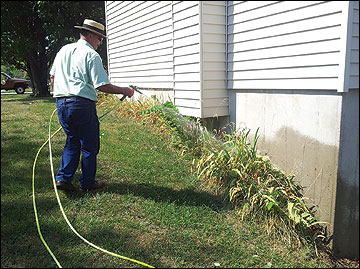 Figure 40
Figure 40
Spraying yard with insecticide.
Applying acaricides
Acaricides can be applied by homeowners themselves or by licensed commercial applicators. Be sure to use a product that lists ticks on the label. Some products are labeled for insects only, and others are mixtures of insecticide and herbicide that don’t include ticks, so examine the label carefully. A single application of an ornamental turf pesticide labeled for ticks and crawling insects has been shown to provide 85 percent or better control and has some residual effect for weeks. Organic pesticides are normally less effective, break down more quickly, and require multiple applications. The possibility that multiple applications of an organic pesticide may be more desirable or safe than a single application of synthetic pesticide has been considered but has not been confirmed.
Anyone who applies acaricides to control ticks must read and follow the container label. If the label is missing, do not use the product. The label is the law for using a product. If you violate the label, you violate the law and can be penalized. The label explains how and where you can legally store, handle, mix, apply and dispose of the acaricide. It also includes information about the ingredients, formulation, pests on which it can be used, hazards to other organisms, protective equipment that should be worn, and first aid instructions.
Follow these general recommendations to minimize risk and increase efficacy when applying acaricides and other pesticides:
- Wear appropriate protective gear as directed on the label when mixing and applying a pesticide.
- Keep pesticides away from areas you do not want to treat.
- Close windows and doors of the home before spraying.
- Do not spray plants that are meant for human consumption, and do not apply to flowering plants where bees and butterflies visit.
- Do not apply pesticides near wetlands, lakes, rivers and streams. Pay particular attention to drinking water sources such as wells or springs.
- Allow pesticides to dry and bind to the substrate before watering treated areas. Watering treated areas immediately after applying a pesticide washes it into nearby waterways.
- To minimize accidental movement (drift) onto areas that are not to be treated, do not spray pesticides on windy days.
- Keep family members and pets, especially cats, out of treated areas for 12 to 24 hours after application to allow the pesticide to dry.
- Store pesticides in their original containers with the label in a cool, dry, secure place out of the reach of children.
- Never pour leftover pesticide down a drain, sink or toilet. Either apply all the pesticide according to the label directions or dispose of it through a community hazardous waste program.
- Empty containers should be rinsed three times, punctured so they cannot be reused, and then placed in the trash.
Toxicity is indicated on a label using one of four signal words from the EPA’s list of toxicity classes. The word gives an indication of how hazardous an acaricide is. If there is no signal word on the label, the product is considered practically nontoxic. The signal words you should look for (listed in order from most hazardous to least hazardous) are as indicated in Figure 41.
 Figure 41
Figure 41
The Environmental Protection Agency (EPA) requires pesticides to carry one of the four signal words on the left to indicate the relative hazard of a pesticide. The meanings of the words are found on the right.
Nonpesticide management
Nonpesticide management practices that have been used with varying effectiveness to manage tick populations primarily include reducing tick habitat and managing host abundance. Wildlife management that discourages activity by deer and rodents, as described in the managing host abundance section, is always crucial. Direct effects on ticks may be achieved without pesticides by using entomopathogenic fungi, diatomaceous earth, insecticidal soap, and botanicals.
Natural enemies of ticks
Ticks have relatively few natural predators, parasites and pathogen. Many of these tick enemies have been investigated for tick control, but few have become commercialized. Some reports have suggested that guinea fowl consume adult ticks in lawns, but the density needed to be effective is unclear. Regardless, guinea fowl are noisy birds and not generally recommended except in areas of low human population. Turkey foraging was not found to reduce adult tick density in localized areas. Several parastic fungi of insects have been examined and commercial formulations of Beauveria bassiana and Metarhizium anisopliae have been tested in research trials and sold as TickEx and Taenure.
Photo credits
All photos were provided by the author, unless otherwise indicated.
Credits
Centers for Disease Control and Prevention (CDC) Connecticut Agriculture Experiment Station, Tick Management Handbook.
